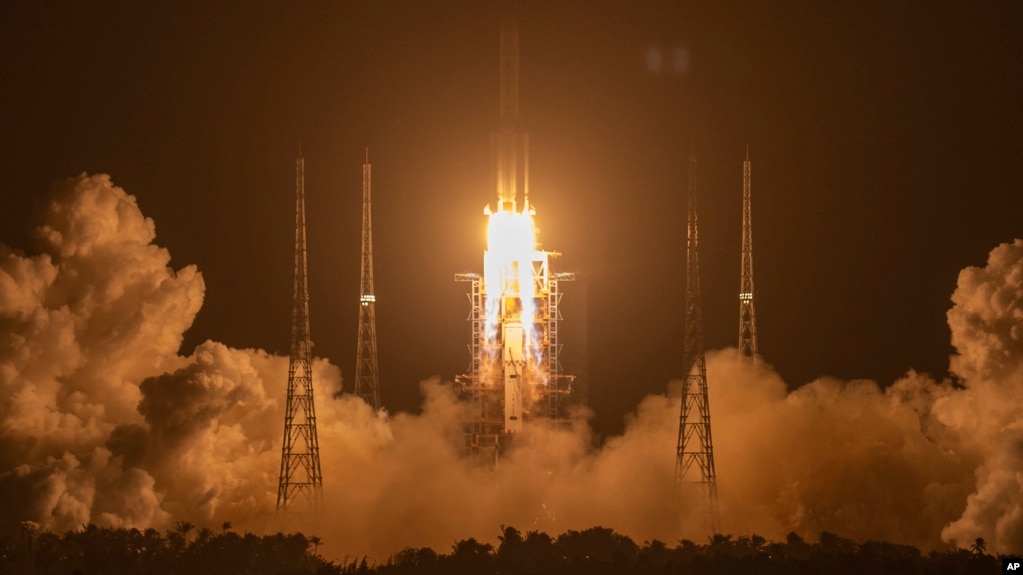
In this Nov. 24, 2020, file photo, a Long March-5 rocket carrying the Chang'e 5 lunar mission lifts off at the Wenchang Space Launch Center in Wenchang in southern China's Hainan Province. (AP Photo/Mark Schiefelbein, File)
Chinese researchers say they believe a group of rockets could be used to change the path of asteroids that might pass near Earth.
A team at China’s National Space Science Center carried out simulations on the proposed asteroid defense system.
The scientists said their research suggests 23 rockets of China’s biggest kind of rockets could force a large asteroid to change direction. They said the rockets could move the asteroid from its path by a distance of 1.4 times Earth’s radius.
Most experts agree that there is only a small likelihood that a large asteroid or other space object will crash into Earth and cause great destruction. However, many organizations do recognize the real risk of such an event.
For example, the U.S. space agency NASA and its international partners continuously search the skies for what scientists call near-Earth objects (NEOs). Such objects include asteroids and comets that come within 50 million kilometers of Earth’s orbit.
The Chinese research was based on defending against a specific asteroid, Bennu, which orbits the sun. Bennu is about a half-kilometer wide. It is considered a near-Earth asteroid. NASA says Bennu reaches its closest distance to Earth every six years.
The researchers recently reported on their proposal in a study in a planetary science publication called Icarus.
China’s Long March 5 rockets are a central part of the country’s space program. They have been used to launch space station elements and carry spacecraft to the Moon and Mars. China has successfully launched six Long March 5 rockets since 2016.
Alan Fitzsimmons is a professor of astrophysics at Queen's University Belfast in Northern Ireland. He told Reuters he finds the idea of using rockets to act as an asteroid deflector "a rather nice concept."
Fitzsimmons continued: "By increasing the mass hitting the asteroid, simple physics should ensure a much greater effect." He added, however, that the actual operation of such a mission needs to be studied further.
Experts have estimated there is about a 1 percent chance that a 100-meter-wide asteroid would strike Earth in the next 100 years, said Gareth Collins. He is a professor at Imperial College London. "Something the size of Bennu colliding is about 10 times less likely," Collins added.
Scientists say deflecting an asteroid's path presents a lower risk than blasting the rock with nuclear explosives, which may cause it to break into pieces without changing direction.
A similar idea has already developed into a planned NASA mission called the Double Asteroid Redirection Test (DART).
Sometime between late 2021 to early 2022, NASA plans to launch the robotic DART spacecraft to reach the near-Earth asteroid Didymos. NASA considers Didymos a “binary asteroid system.” This means it is made up of a large, main asteroid, and a smaller “moonlet” asteroid.
NASA says when the DART spacecraft arrives at Didymos about a year after launch, it will attempt to crash land on the moonlet. The test seeks to find out how the crash will affect the asteroid's travel path.
Words in This Story
asteroid – n. a rocky object that goes around the sun like a planet
simulation – n. a creation of something that behaves or looks like something real but is not
radius – n. the distance from the center of a circle to its edge
comet – n. an object in space that leaves a bright line behind it in the sky
concept – n. an idea of principle
collide – v. to strike an object
Comprehension Quiz
1. What is the story mainly about?
2. What is planetary science publication called?
3. Who is Alan Fitzsimmons?
4. What did Alan Fitzsimmons tell Reuters?
5. How wide is Bennu?